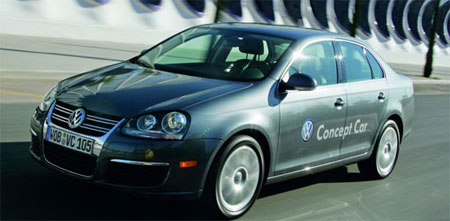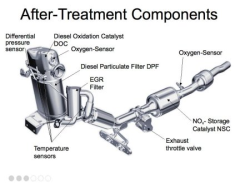

The new, fifty-state legal Jetta BlueTDI is finally done and it's coming soon. At the International Vienna Motor Symposium in Austria, Volkswagen announced that it's completed development on what they are calling the BlueTDI system for their US diesels. Like Mercedes (BlueTec) and BMW (BluePerformance), VW is adopting the Blue moniker for their cleanest, most efficient systems. The Jetta BlueTDI will be the first Tier2 Bin5 compliant diesels that doesn't have to use a urea injection system to meet the new NOx emissions standard. VW started with the updated 2.0L TDI that was launched in the European Tiguan last fall. Individual cylinder pressure sensors were added that allow the engine management system to optimize the fuel injection pulses to keep combustion temperatures down. That helped VW eliminate 60-percent of the NOx emissions before you even get to the exhaust stream. The exhaust gas flowing from the 2.0L engine are low enough that VW was able to use a lean NOx trap to convert the remaining NOx to nitrogen and water. However, the larger 3.0L V-6 TDI that is coming in the Touareg and Audi Q7 at the end of the year will have to use urea injection. In addition to the NOx trap, there is a particulate filter to eliminate the soot often associated with diesel engines. The new Jetta will be able to get up to 60mpg when cruising on the highway, a boost of 12-percent over the last US-market Jetta TDI from 2006. The Jetta BlueTDI should be the first of the new round of diesels to come to market when it arrives later this summer. The first batch of cars should actually start arriving at US dealers in June, where they will be available for test drives through the summer before going on sale in September.
Vienna Motor Symposium 2008: BlueTDI development completed successfully
BlueTDI will debut midyear in North America
The U.S. version of the Jetta will be the first to use BlueTDI
Wolfsburg, 24 April 2008 - At the International Vienna Motor Symposium (24-25 April), Volkswagen is to introduce the production version of the BlueTDI, a next-generation turbo diesel developed especially for the North American market. The common rail engine is based on the high-tech TDI, which was first introduced in Europe in 2007 with the Tiguan. This engine already satisfies the Euro-5 standard that comes into effect in autumn 2009. In order to meet specific operating conditions in the U.S., this four-cylinder engine was redeveloped with internal engine modifications and a NOx trap.
Background information: Five U.S. states1, including California, currently have the strictest emissions standards in the world (BIN5/LEV2). In spite of variations in fuel quality, which are more dramatic in the U.S. than in Europe, the new BlueTDI meets these emissions standards. The engine will debut in the U.S. Jetta this summer. For years, the Limousine has been the most popular and successful European-manufactured car on the American market, especially as a diesel.
The Jetta BlueTDI will debut as one of the cleanest and most economic cars of its class in the world. In the run-up to the Vienna Motor Symposium, Dr. Ing. Jens Hadler, Director of Volkswagen Powertrain Development comments, "high fuel prices and a dramatic change in environmental consciousness means that diesel is becoming more and more attractive for American drivers every day." Dr. Hadler continues, remarking, "this is why many customers, especially in California, have been waiting for a super-clean diesel like our BlueTDI. I think this motor will help the diesel get its big break in America because it consumes so little and yet can go such long distances on a single fill-up. And in a country as big as the United States, this is a priceless advantage. On the highway, for example, this engine can reach up to 60 miles per gallon2. This is an improvement of 12 percent over its predecessor, which had a lower capacity and higher emissions."
A key aspect in the development of the BlueTDI (2.0 litre engine displacement, 103 kW/140 PS, 320 Nm) was the reduction of nitrogen oxide emissions (NOx); the American BIN5/LEV2 standards stipulate a nitrogen oxide limit of only 0.05 g/mile. The engineers in Wolfsburg met this limit and the general reduction of raw emissions by using internal engine modifications, some of which are unique worldwide, and implementing the maintenance-free NOx trap.
These internal engine changes include modifications to the design of the injection system of both the American and European TDI as well as the implementation of cylinder pressure sensors. This allows for a completely new type of cylinder pressure-based combustion control, which is both faster and tailored to each specific cylinder. Also new on-board: an optimised high-pressure injection pump. Another unique feature is the combination of a high-pressure exhaust gas recirculation system with additional low-pressure exhaust gas recirculation. This dual exhaust gas recirculation (dual circuit EGR) is an effective means of reducing nitrogen oxides in the engine. The dual circuit EGR system alone reduces NOx by up to 60 percent.
Outside of the engine, it is the NOx trap – connected downstream of the oxidation catalytic converter and the particle filter – that reduces nitrogen oxide to an absolute minimum. Implemented together, these measures reduce nitrogen oxide emissions by 90 percent. Drive the Jetta BlueTDI and you will be driving one of the most economical and environmentally-friendly cars in America.
1) = BIN5 states: California, Massachusetts, Maine, New York and Vermont.
2) = MPG (miles per gallon) is the standard range specification in the U.S. for describing fuel consumption.
[ Via: Autoblog (Volkswagen) ]
[ Tag: bluetdi, bluetdi-jetta, jetta, jetta bluetdi, jetta diesel, jetta tdi, JettaBluetdi, JettaDiesel, jettatdi ]
0 comments:
Post a Comment